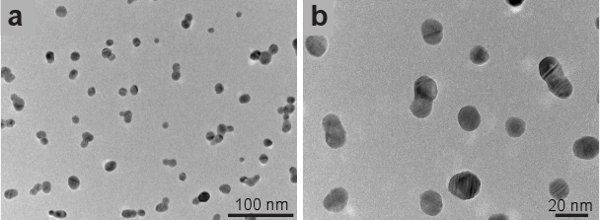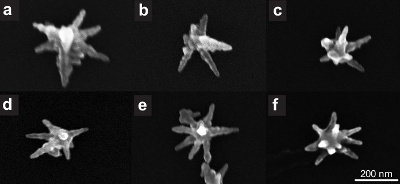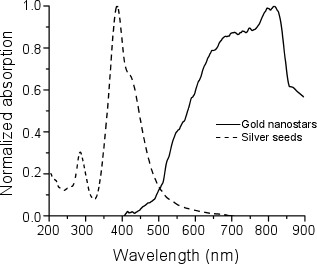需要订阅 JoVE 才能查看此. 登录或开始免费试用。
Method Article
黄金Nanostar合成银种子介导的生长方法
摘要
我们合成了星形黄金nanostars使用银种子介导的增长方式。 nanostars直径范围从200到300 nm,并提示7日至10不等。纳米粒子具有广泛的表面等离子体共振模式在近红外的中心。
摘要
纳米级胶体的物理,化学和光学特性取决于他们的物质组成,大小和形状1-5。有极大的兴趣,在光热消融,药物输送和许多其他医学领域的应用中使用的纳米胶体。黄金特别是因为它的低毒性 7-9 。金属纳米胶体的财产是他们能有一个强有力的表面等离子体共振 10 。表面等离子体共振模式的峰值取决于金属纳米胶体的结构和组成。由于表面等离子体共振模式是与光的刺激,有必要在近红外生物组织透射率是最大的 11,12峰吸光度。
我们提出了一个方法来合成星形胶体金,又称星形13-15纳米粒子或nanostars 16。这种方法是基于作为olution含银种子是用来作为核剂的胶体金17-22各向异性增长。扫描电子显微镜(SEM)分析所产生的金胶体的结果显示,70%的纳米结构nanostars。其余30%的颗粒无定形集群decahedra和菱形。在近红外(840 nm)的吸收峰的nanostars检测。因此,我们的方法生产的黄金nanostars适用于生物医学应用,特别是光热消融。
研究方案
1。银种子准备
- 准备通过利用一个任意的质量和混合10毫升的去离子(DI)水的原液的硝酸银 (硝酸银)。计算的解决方案的摩尔。保持在一个黑暗的地方隔离开光的解决方案。
- 添加柠檬酸钠三元14.7毫克(钠3 C 6 H 5 O 7)10毫升去离子水,使一个5毫米的解决方案。摇动小瓶直至粉末溶解。
- 10毫升去离子水15.1毫克的硼氢化钠(硼氢化钠 4)添加到另一个小瓶,使40毫米的解决方案。立即关闭小瓶。用手轻轻摇动的解决方案,并放置在一个冰的烧杯。放置在冰箱的烧杯中,并启动一个定时器(T1 = 0)。新鲜制作的解决方案将用于在15分钟这是有足够的时间冷却下来。
- 从硝酸银,1.1)的股票解决方案,准备在0.25毫米10毫升。放置一个小瓶和ST搅拌磁铁艺术搅拌。
- 加入0.25毫升柠檬酸钠三元解决方案1.2)1.4)。
- 在t 1 = 15分钟去除硼氢化钠溶液,1.3),从冰箱中。用吸管取0.4毫升这一解决方案,并把它添加到1.5)。注:在一个单一的快速中风解决方案。颜色会变成黄色。搅拌5分钟的解决方案。
- 在t 1 = 20分钟停止搅拌,取出小瓶磁铁和小瓶保持在黑暗的地方。不要关闭小瓶。
- 使用前在室温避光保持至少2个小时的解决方案。最好使用一个星期内从准备的种子。
2。生长溶液的制备
- 准备140毫克,加入10毫升去离子水抗坏血酸(C 6 H 8 O 6)80毫米。
- 准备10毫升的氯化金(HAuCl 4)浓缩液。计算解决方案摩尔。保持的solutioñ从光隔离。
- 准备50毫米十六烷基三甲基溴化铵(CTAB法- C 19 H 42 BRN)20毫升,加入20毫升去离子水364毫克一小瓶。立即放入小瓶一种震撼人心的磁铁,并开始搅拌在一个温暖的板30 ° C。后CTAB的粉末完全溶解,溶液变成透明关闭该板块的热水器,但不断搅拌至步骤2.7)。
- 添加解决方案1.1)的解决方案2.3),获得最终摩尔4.9x10 -2毫米。启动一个定时器(T 2 = 0)。
- 在t 2 = 1分钟将解决方案添加2.2)2.4),获得了0.25毫米的最后摩尔。
- 在T 2 = 2分加0.1毫升)2.1〜2.5)。该解决方案将变成无色。
- 在t 2 = 2分20秒增加0.05毫升1.8)(银种子)为2.6)。搅拌15分钟的暂停。受最初将变成蓝色,然后棕色。
- 在t 2 = 17分钟停止搅拌,取出米agnet和室温保持在24小时暂停。
3。 CTAB的分离鉴定或实验成像,黄金nanostars
注:CTAB法可在室温下结晶。解散了金胶体晶体加热至30 ° C,或沉浸在热自来水的小瓶,直到晶体溶解。
- 超声暂停2分钟。
- 离心5分钟730 RCF暂停。 Nanostars将堆积在管壁。
- 删除尽可能多的暂停与照顾不删除的nanostars吸管。
- 加入DI水管和超声2分钟。
- 3分钟460 RCF离心暂停。暂停含有CTAB的少,因此较低的离心力需要单独的nanostars。
- 重复步骤3.3)和3.4)。
- 加入去离子水380 RCF 3分钟的暂停和离心机。
- Repea吨步骤3.3)和3.4)。 nanostars成像光谱仪,或实验。
4。代表性的成果:
图1显示了透射电子显微镜的银种子成像使用的JEOL 2010 - F透射电镜(TEM)图像。种子有球形和15纳米的平均规模。黄金nanostars成像使用一台日立的S - 5500扫描电子显微镜(SEM)模式。图2显示了我们的方法合成的nanostars增加放大倍率。星形颗粒约70%的胶体颗粒。非形成的恒星看起来像decahedra和菱形的无定形簇(未显示)。图3显示了几个单一的黄金nanostars。 nanostars范围从200 nm至300 nm和提示的大小不等的7至10。如果他们保留它们的形状合成后的1个月至少这是留在CTAB法合成纳米金。
e_content"我们测量使用OLIS卡里- 14分光光度计的银种子和nanostars吸收光谱吸收峰在400 nm的种子,而吸收峰800 nm和850 nm处(图4之间的nanostars )。
图1银种子透射电子显微镜图像。

图2:黄金nanostars扫描电子显微镜图像。

图3:单金nanostars扫描电子显微镜图像。

图4银种子规范化的吸收光谱(虚线)和金nanostars(实线)。
讨论
在这项工作中,我们提出了一个方法来合成黄金nanostars使用银种子。我们发现,银种子产量的70%nanostars生产。 nanostars近红外吸收峰,对应其表面等离子体共振模式,800纳米和850纳米,23间为中心的。这些物业允许使用医学领域的应用24日至26日 ,如光热消融,我们的黄金nanostars。
一个方法之间的主要区别在这里所说的其他方法是使用,而不是黄金白银种子。...
披露声明
没有利益冲突的声明。
致谢
这项研究得到了国家科学基金会为材料的研究和教育伙伴关系(PREM)批准号:DMR - 0934218。它也支持奖号码为国家研究资源中心2G12RR013646 - 11。内容完全是作者的责任,并不代表官方意见的国家研究资源或国家卫生研究院中心。
材料
| Name | Company | Catalog Number | Comments |
| 试剂名称 | 公司 | 目录编号 | 纯度 |
| 柠檬酸钠三元脱水 | 西格玛 | S4641 | 99.0% |
| 硝酸银 | 爱秩序 | 204390 | 99.9999% |
| 硼氢化钠 | 爱秩序 | 213462 | 99% |
| L -抗坏血酸 | Sigma - Aldrich公司 | 255564 | 99% |
| 黄金氯化三水 | 爱秩序 | 520918 | 99.9%以上 |
| 十六溴铵(CTAB) | 西格玛 | H6269 |
| 设备名称 | 公司 | 评论 |
| JEOL 2010 - F | JEOL | 透射电子显微镜 |
| 日立S - 5500 | 日立 | 使用扫描电子显微镜模式 |
| OLIS卡里- 14分光光度计 | OLIS | 分光光度计 |
参考文献
- Irimpan, L., Nampoori, V. P. N., Radhakrishnan, P., Krishnan, B., Deepthy, A. Size-dependent enhancement of nonlinear optical properties in nanocolloids of ZnO. Journal of Applied Physics. 103, (2008).
- Sharma, V., Park, K., Srinivasarao, M. Colloidal dispersion of gold nanorods: Historical background, optical properties, seed-mediated synthesis, shape separation and self-assembly. Materials Science and Engineering: R: Reports. 65, 1-38 (2009).
- El-Sayed, M. A. Some interesting properties of metals confined in time and nanometer space of different shapes. Accounts of Chemical Research. 34, 257-2564 (2001).
- Daniel, M. C., Astruc, D. Gold nanoparticles: assembly, supramolecular chemistry, quantum-size-related properties, and applications toward biology, catalysis, and nanotechnology. Chemical reviews. 104, 293-346 (2004).
- Burda, C., Chen, X., Narayanan, R., El-Sayed, M. A. Chemistry and Properties of Nanocrystals of Different Shapes. Chemical reviews. 105, 1025-1102 (2005).
- Hu, M., Chen, J. Y. X., Li, J. Y., Au, L., Hartland, G. V., Li, X. D., Marquez, M., Xia, Y. N. Gold nanostructures: engineering their plasmonic properties for biomedical applications. Chemical Society Reviews. 35, 1084-1094 (2006).
- Seo, J. T., Yang, Q., Kim, W. J., Heo, J., Ma, S. M., Austin, J., Yun, W. S., Jung, S. S., Han, S. W., Tabibi, B., Temple, D. Optical nonlinearities of Au nanoparticles and Au/Ag coreshells. Opt. Lett. 34, 307-309 (2009).
- Jeong, S., Choi, S. Y., Park, J., Seo, J. -. H., Park, J., Cho, K., Joo, S. -. W., Lee, S. Y. Low-toxicity chitosan gold nanoparticles for small hairpin RNA delivery in human lung adenocarcinoma cells. Journal of Materials Chemistry. 21, 13853-13859 (2011).
- Huang, X., Jain, P. K., El-Sayed, I. H., El-Sayed, M. A. Gold nanoparticles: interesting optical properties and recent applications in cancer diagnostics and therapy. Nanomedicine. 2, 681-693 (2007).
- Link, S., El-Sayed, M. A. Shape and size dependence of radiative, non-radiative and photothermal properties of gold nanocrystals. International Reviews in Physical Chemistry. 19, 409-453 (2000).
- El-Sayed, I. H., Huang, X. H., El-Sayed, M. A. Selective laser photo-thermal therapy of epithelial carcinoma using anti-EGFR antibody conjugated gold nanoparticles. Cancer Letters. 239, 129-135 (2006).
- O'Neal, D. P., Hirsch, L. R., Halas, N. J., Payne, J. D., West, J. L. Photo-thermal tumor ablation in mice using near infrared-absorbing nanoparticles. Cancer Letters. 209, 171-176 (2004).
- Nehl, C. L., Liao, H. W., Hafner, J. H. Optical properties of star-shaped gold nanoparticles. Nano Letters. 6, 683-688 (2006).
- Pazos-Perez, N., Rodriguez-Gonzalez, B., Hilgendorff, M., Giersig, M., Liz-Marzan, L. M. Gold encapsulation of star-shaped FePt nanoparticles. Journal of Materials Chemistry. 20, 61-64 (2010).
- Sahoo, G. P., Bar, H., Bhui, D. K., Sarkar, P., Samanta, S., Pyne, S., Ash, S., Misra, A. Synthesis and photo physical properties of star shaped gold nanoparticles. Colloids and Surfaces A: Physicochemical and Engineering Aspects. , 375-371 (2011).
- Senthil Kumar, P., Pastoriza-Santos, I., Rodriguez-Gonzalez, B., Garcia de Abajo, F. J., Liz-Marzan, L. M. High-yield synthesis and optical response of gold nanostars. Nanotechnology. 19, (2008).
- Goodrich, G. P., Bao, L. L., Gill-Sharp, K., Sang, K. L., Wang, J., Payne, J. D. Photothermal therapy in a murine colon cancer model using near-infrared absorbing gold nanorods. Journal of Biomedical Optics. 15, (2010).
- Zhang, D., Neumann, O., Wang, H., Yuwono, V. M., Barhoumi, A., Perham, M., Hartgerink, J. D., Wittung-Stafshede, P., Halas, N. J. Gold Nanoparticles Can Induce the Formation of Protein-based Aggregates at Physiological pH. Nano Lett. 9, 666-671 (2009).
- Alkilany, A. M., Nagaria, P. K., Hexel, C. R., Shaw, T. J., Murphy, C. J., Wyatt, M. D. Cellular uptake and cytotoxicity of gold nanorods: molecular origin of cytotoxicity and surface effects. Small. 5, 701-708 (2009).
- Sun, L., Liu, D., Wang, Z. Functional gold nanoparticle-peptide complexes as cell-targeting agents. Langmuir. 24, 10293-10297 (2008).
- Park, J., Estrada, A., Sharp, K., Sang, K., Schwartz, J. A., Smith, D. K., Coleman, C., Payne, J. D., Korgel, B. A., Dunn, A. K., Tunnell, J. W. Two-photon-induced photoluminescence imaging of tumors using near-infrared excited gold nanoshells. Opt. Express. 16, 1590-1599 (2008).
- Nikoobakht, B., El-Sayed, M. A. Preparation and growth mechanism of gold nanorods (NRs) using seed-mediated growth method. Chemistry of Materials. 15, 1957-1962 (2003).
- Hao, F., Nehl, C. L., Hafner, J. H., Nordlander, P. Plasmon resonances of a gold nanostar. Nano Letters. 7, 729-732 (2007).
- Hao, F., Nordlander, P., Sonnefraud, Y., Dorpe, P. V. a. n., Maier, S. A. Tunability of Subradiant Dipolar and Fano-Type Plasmon Resonances in Metallic Ring/Disk Cavities: Implications for Nanoscale Optical Sensing. ACS Nano. 3, 643-652 (2009).
- Sweeney, C. M., Hasan, W., Nehl, C. L., Odom, T. W. Optical Properties of Anisotropic Core-Shell Pyramidal Particles. Journal of Physical Chemistry A. 113, 4265-4268 (2009).
- Dickerson, E. B., Dreaden, E. C., Huang, X. H., El-Sayed, I. H., Chu, H. H., Pushpanketh, S., McDonald, J. F., El-Sayed, M. A. Gold nanorod assisted near-infrared plasmonic photothermal therapy (PPTT) of squamous cell carcinoma in mice. Cancer Letters. 269, 57-66 (2008).
- Jana, N. R., Gearheart, L., Murphy, C. J. Wet chemical synthesis of high aspect ratio cylindrical gold nanorods. Journal of Physical Chemistry B. 105, 4065-4067 (2001).
- Jana, N. R., Gearheart, L., Murphy, C. J. Seed-mediated growth approach for shape-controlled synthesis of spheroidal and rod-like gold nanoparticles using a surfactant template. Advanced Materials. 13, 1389-1393 (2001).
- Xiao, J., Qi, L. Surfactant-assisted, shape-controlled synthesis of gold nanocrystals. Nanoscale. 3, 1383-1396 (2011).
- Tao, A. R., Habas, S., Yang, P. Shape control of colloidal metal nanocrystals. Small. 4, 310-325 (2008).
- Cole, J. R., Mirin, N. A., Knight, M. W., Goodrich, G. P., Halas, N. J. Photothermal Efficiencies of Nanoshells and Nanorods for Clinical Therapeutic Applications. Journal of Physical Chemistry C. 113, 12090-12094 (2009).
- Choi, J. S., Park, J. C., Nah, H., Woo, S., Oh, J., Kim, K. M., Cheon, G. J., Chang, Y., Yoo, J., Cheon, J. A hybrid nanoparticle probe for dual-modality positron emission tomography and magnetic resonance imaging. Angew. Chem. Int. Ed. Engl. 47, 6259-6262 (2008).
- Chithrani, B. D., Ghazani, A. A., Chan, W. C. W. Determining the Size and Shape Dependence of Gold Nanoparticle Uptake into Mammalian Cells. Nano Letters. 6, 662-668 (2006).
转载和许可
请求许可使用此 JoVE 文章的文本或图形
请求许可探索更多文章
This article has been published
Video Coming Soon
版权所属 © 2025 MyJoVE 公司版权所有,本公司不涉及任何医疗业务和医疗服务。